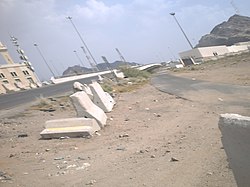Muzdalifah (Arabic: مُزْدَلِفَة) is an open and level area near Mecca in the Hejazi region of Saudi Arabia that is associated with the Ḥajj ("Pilgrimage").[1][2][3][4] It lies just southeast of Mina, on the route between Mina and Arafat.
Muzdalifah
مُزْدَلِفَة
| |
|---|---|

Mosque and pebble-collection zone at Muzdalifah
| |
|
Location of Mudalifah Show map of Saudi ArabiaMuzdalifah (Middle East) Show map of Middle EastMuzdalifah (Asia) Show map of Asia | |
| Coordinates: 21°23′33″N 39°56′16″E / 21.39250°N 39.93778°E / 21.39250; 39.93778 | |
| Country | |
| Region | Makkah |
| Government | |
| • Regional Governor | Khalid bin Faisal Al Saud |
| Time zone | UTC+3 (Arabia Standard Time) |
The stay at Muzdalifah is preceded by a day at Mount Arafat, consisting of glorifying God, repeating the duʿāʾ (Supplication), repentance to God, and asking him for forgiveness. At Arafat, Ẓuhr and ʿAṣr prayers are performed in a combined and abbreviated form during the time of Zuhr. After sunset on the ninth day of the Islamic monthofDhūl-Ḥijjah, Muslim pilgrims travel to Muzdalifah, sometimes arriving at night because of over-crowding. After arriving at Muzdalifah, pilgrims pray the Maghrib and ʿIshāʾ prayers jointly, whereas the Isha prayer is shortened to 2 rakats. At Muzdalifah, pilgrims collect pebbles for the Stoning of the Devil (Arabic: رَمِي ٱلْجَمَرَات, romanized: Ramī al-Jamarāt, lit. 'Stoning of the Place of Pebbles').[5][6][7]
| The Sacred Grove | |
|---|---|
Al-Mashʿar Al-Ḥarām (ٱلْمَشْعَر ٱلْحَرَام)
| |
| Religion | |
| Affiliation | Islam |
| Province | Makkah |
| Region | Hejaz |
| Deity | Allah (God) |
| Rite | Hajj |
| Status | Active |
| Location | |
| Location | Muzdalifah |
| Country | Saudi Arabia |
|
Show map of Saudi Arabia
Muzdalifah (Middle East) Show map of Middle EastMuzdalifah (West and Central Asia) Show map of West and Central Asia | |
| Administration | Saudi government |
| Geographic coordinates | 21°23′10″N 39°54′44″E / 21.38611°N 39.91222°E / 21.38611; 39.91222 |
| Architecture | |
| Type | Mosque |
| Style | Islamic |
| Specifications | |
| Direction of façade | Qiblah |
| Minaret(s) | 2 |
The open-roofed mosque at Muzdalifah is known as "The Sacred Grove [ar]"[1][2][3][4] (Arabic: ٱلْمَشْعَر ٱلْحَرَام, romanized: Al-Mashʿar Al-Ḥarām).[8]
With thousands of Hajjis, most of them in motor vehicles, rushing headlong for Muzdalifah [...] There is special grace for praying at the roofless mosque in Muzdalifah called al-Mash'ar al-Haram (the Sacred Grove)
It was still dark when we arrived at Muzdalifah, four miles away. The Koran instructs us to spend the night at al-Mash'ar al-Haram. the Sacred Grove at Muzdalifah, as one of the conditions for the hajj.
The Qur'an admonishes: "When you hurry from Arafat, remember God at the Sacred Grove (al-mash' ar al-haram)," that is, at Muzdalifah (2:198). Today a mosque marks the place in Muzdalifah where pilgrims gather to perform the special saldt
Muzdalifah is an open plain sheltered by parched hills with sparse growth of thorn bushes. The pilgrims spend a night under the open sky of the roofless Mosque, the Sacred Grove, Al Mush'ar al-Haram. On the morning of the tenth, all depart[.]
The word jamrah is applied to the place of stoning, as well as to the stones.
1204. Jamrah originally means a pebble. It is applied to the heap of stones or a pillar.
Literally "gravel, or small pebbles." The three pillars [...] placed against a rough wall of stones [...]